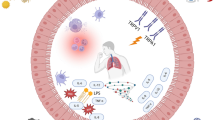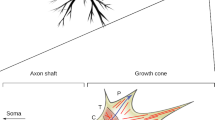Summary
The amount of adenosine triphosphate (ATP) in hamster trachea organ cultures was determined with a technique based on light emission from a luciferin/luciferase/ATP reaction. The amount of ATP, expressed as ng per mg dry weight, was consistent in tracheal explants prepared from various animals and changed negligibly when explants were cultivated in vitro for several days. The amount of ATP was related directly to cellular activity and integrity in the epithelium since inactivation by heat or freeze-thaw rapidly depleted measurable ATP, and ciliary activity and ATP content were related directly. When tracheal explants were infected with 105 to 107 CFU of virulentMycoplasma pneumoniae cells, both ciliary activity and ATP content in the tissue dropped dramatically after approximately 5 to 8 days (up to 85% and 60% decreases, respectively). Exposure of explants to 50 to 200 μg per ml of purifiedM. pneumoniae membranes also caused significant decreases in ciliary activity and ATP. When explants were infected with attenuated or nonvirulent mycoplasmas, ciliary activity was only slightly decreased, while ATP values often rose slightly. The technology associated with the determination of ATP levels in tracheal explants should prove useful as a new, objective, analytical approach to cell viability in organ cultures.
Similar content being viewed by others
References
Hoorn, B., and D. A. J. Tyrell. 1965. Organ cultures in virology. Prog. Med. Virol. 11: 408–450.
Gabridge, M. G. 1975. Hamster trachea organ cultures. TCA Manual 1: 75–80.
Hoorn, B. 1966. Organ cultures of ciliated epithelium for the study of respiratory viruses. Acta Pathol. Microbiol. Scand. (Suppl. 183) 66: 1–37.
Butler, M. 1969. Isolation and growth of mycoplasmas in human embryo trachea cultures. Nature 224: 605–606.
Gabridge, M. G. 1975. Oxygen consumption by trachea organ cultures infected withMycoplasma pneumoniae. Infect. Immun. 12: 544–549.
Gabridge, M. G. 1976. Microrespirometer chamber for determinations of viability in cell and organ cultures. J. Clin. Microbiol. 3: 560–565.
Gabridge, M. G., and R. Polisky. 1976. Quantitative reduction of 2,3,4-triphenyl tetrazolium chloride by hamster trachea organ cultures: effect ofMycoplasma pneumoniae cells and membranes. Infect. Immun. 13: 84–91.
Hu, P. C., A. M. Collier, and J. B. Baseman. 1975. Alterations in the metabolism of hamster trachea in organ culture after infection by virulentMycoplasma pneumoniae. Infect. Immun. 11: 704–710.
Allison, A. C. 1974. Subcellular pathology. In: F. Beck, and J. Lloyd (Eds.),The Cell in Medical Science. Vol. 1. Academic Press, New York, pp. 315–353.
Gabridge, M. G., S. E. Singer, and R. E. Esposito. 1976. Gradient, polyacrylamide gel electrophoresis of proteins from cytotoxic mycoplasma membranes. Biochem. Biophys. Res. Commun. 70: 271–279.
Gabridge, M. G., S. F. Singer, and R. E. Esposito. 1976. Cultivation of mycoplasmas in a modified tissue culture medium. Appl. Environ. Microbiol. 31: 986–989.
Engleman, D. M., T. M. Terry, and H. J. Morowitz. 1967. Characterization of the plasma membrane ofMycoplasma laidlawii. I. Sodium dodecyl sulfate solubilization. Biochim. Biophys. Acta 135: 381–390.
Lamprecht, W., and I. Trautschold. 1963. In: H. U. Bergmeyer (Ed.),Methods of Enzymatic Analysis. Academic Press, New York, p. 543.
Allen, P. O. 1973. Development of the luminescence biometer for microbial detection. Dev. Ind. Microbiol. 14: 67–73.
DeLuca, M., M. E. Dempsey, K. Hori, and M. J. Cormier. 1976. Source of oxygen in the CO2 produced during chemiluminescence of firefly luciferyl-adenylate and renilla luciferin. Biochem. Biophys. Res. Commun. 69: 262–267.
Lundin, A., and A. Thore. 1975. Analytical information obtainable by evaluation of the time course of firefly bioluminescence in the assay of ATP. Anal. Biochem. 66: 47–63.
Morton, R. A., T. A. Hopkins, and H. H. Sebiger. 1969. The spectroscopic properties of firefly luciferin and related compounds. An approach to product emission. Biochemistry 8: 1598–1607.
Hamerstadt, R. H. 1973. An automated method for ATP analysis utilizing the luciferin-luciferase reaction. Anal. Biochem. 52: 449–455.
Johnson, R., J. H. Gentile, and S. Cheer. 1974. Automatic sample injector. Its application in the analysis of adenosine triphosphate. Anal. Biochem. 60: 115–121.
Thore, A., A. Lundin, and S. Bergman. 1975. Detection of bacteriuria by luciferase assay of adenosine triphosphate. J. Clin. Microbiol. 1: 8.
Cole, H. A., J. W. T. Wimpenny, and D. E. Hughes. 1967. The ATP pool inEscherichia coli. I. Measurement of the pool using a modified luciferase assay. Biochim. Biophys. Acta 143: 443–445.
Aledort, L. M., R. I. Weed, and S. B. Troup. 1966. Ionic effects on firefly bioluminescence assay of red blood cell ATP. Anal. Biochem. 17: 268–277.
Hammar, H., G. Wettermark, and W. Wladimiroff. 1975. Bioluminescence assay of enzymes obtained from buccal epithelium by superficial scraping. Scand. J. Dent. Res. 83: 375–381.
Stephens, R. E. 1974. Enzymatic and structural proteins of the axoneme, In: M. A. Sleigh (Ed.),Cilia and Flagella Academic Press, New York, pp. 39–76.
McCallum, R. E., and C. P. Sword. 1972. Mechanisms of pathogenesis inListeria monocytogenes infection. V. Early imbalance in host energy metabolism during experimental listeriosis. Infect. Immun. 5: 863–871.
Lane, B. P., and R. Gordon. 1974. Regeneration of rat tracheal epithelium after mechanical injury. I. The relationship between mitotic activity and cellular differentiation. Proc. Soc. Exp. Biol. Med. 145: 1139–1144.
Author information
Authors and Affiliations
Additional information
This investigation was supported in part by the National Institutes of Health (PHS Grant AI 12559), by a Biomedical Sciences Support Grant made to the University of Illinois School of Life Sciences, and by the University Research Board.
Rights and permissions
About this article
Cite this article
Gabridge, M.G., Polisky, R.B. Intracellular levels of adenosine triphosphate in hamster trachea organ cultures exposed toMycoplasma pneumoniae cells or membranes. In Vitro 13, 510–516 (1977). https://doi.org/10.1007/BF02615144
Issue Date:
DOI: https://doi.org/10.1007/BF02615144




